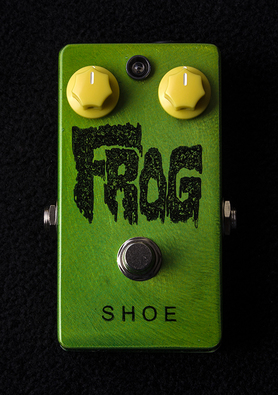FROG: PSYCHEDELIC OCTAVE

The Frog is back by popular demand after a few world tours and records and such. Frog gets its name, of course, from its sound. Try sweeping up and down on a major barre chord around fret 10 or so and you’ll get a good demonstration of its characteristic ribbit. Of course, at heart, the Frog is a differential pair octave surrounded by carefully tuned class A MOSFET amplifiers. The result is less an Octave Fuzz and more an Octave boost or overdrive. This makes it very useful when playing through high gain amps that can give a lot of octave fuzzes problems. With the gain at minimum you can get a clear and clean(ish) octave up effect that is perfect for clean or overdriven amps and also stacks well into other drive pedals and fuzzes (Savior Machine, Robert, and Pixel are some favorites for this). You can also get some ring modulation type sounds out of the pedal by playing certain note combinations in the “clean” range.
Crank up the Gain Knob and you start to get into 60s Psychedelic territory that works great for Jimi type leads.
As stated, you can also use it on some chords. Major chords and power chords generally yield interesting and pleasant results and you will find you can get usable octave sounds not only out of your strats but also out of humbucker equipped guitars. As with all analog octave up effects, the neck pickup tends to give the strongest octave up sounds and playing higher up on the neck also yields the most singing lead tones. However, the Frog is more forgiving than many other octaves and you can stray farther down than the old “above the 12th fret” limitations. Have at it and make some crazy sounds! Or nice sounds if that’s your thing.
Controls:
Volume (Left): Use this to set the output level of the effect. At lower Gain settings you will want to turn this up and at the highest Gain settings you will get some high levels out of the pedal so you will likely want to turn it down a bit or risk the wrath of your bandmates/spouse, etc.
Gain (Right): Turn all the way down for the cleanest octave and ringmod type sounds. You will likely want to be in the lower range if you plan to stack the pedal with others or use it into a distorted amp (which not frowned upon with the Frog). Turn up for more overdrive/distortion and a lot more volume (be careful not to blow yourself away, please).
POWER: Please note that SHOE pedals do not run on batteries. You will need a standard 2.1 mm center negative 9V power supply (as used on most pedals) in order to run them. Power consumption is extremely low for all SHOE pedals (less than 5mA and for some pedals even below 1mA) so virtually any pedal power supply of the correct polarity can run more than one SHOE pedal on a daisy chain.
Crank up the Gain Knob and you start to get into 60s Psychedelic territory that works great for Jimi type leads.
As stated, you can also use it on some chords. Major chords and power chords generally yield interesting and pleasant results and you will find you can get usable octave sounds not only out of your strats but also out of humbucker equipped guitars. As with all analog octave up effects, the neck pickup tends to give the strongest octave up sounds and playing higher up on the neck also yields the most singing lead tones. However, the Frog is more forgiving than many other octaves and you can stray farther down than the old “above the 12th fret” limitations. Have at it and make some crazy sounds! Or nice sounds if that’s your thing.
Controls:
Volume (Left): Use this to set the output level of the effect. At lower Gain settings you will want to turn this up and at the highest Gain settings you will get some high levels out of the pedal so you will likely want to turn it down a bit or risk the wrath of your bandmates/spouse, etc.
Gain (Right): Turn all the way down for the cleanest octave and ringmod type sounds. You will likely want to be in the lower range if you plan to stack the pedal with others or use it into a distorted amp (which not frowned upon with the Frog). Turn up for more overdrive/distortion and a lot more volume (be careful not to blow yourself away, please).
POWER: Please note that SHOE pedals do not run on batteries. You will need a standard 2.1 mm center negative 9V power supply (as used on most pedals) in order to run them. Power consumption is extremely low for all SHOE pedals (less than 5mA and for some pedals even below 1mA) so virtually any pedal power supply of the correct polarity can run more than one SHOE pedal on a daisy chain.
EXAMPLE USES:
|
|
|